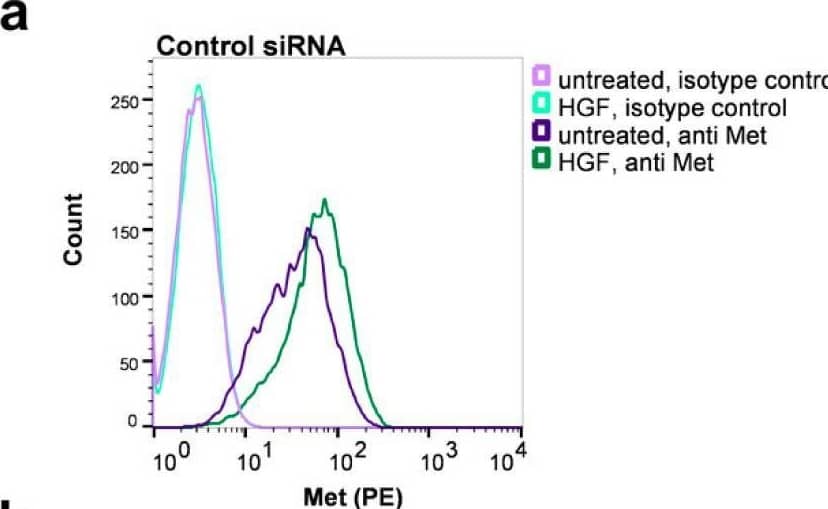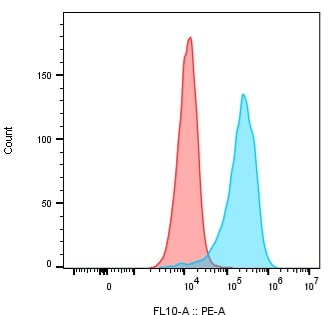Human HGFR/c-MET PE-conjugated Antibody Summary
Glu25-Thr932
Accession # P08581
Applications
Please Note: Optimal dilutions should be determined by each laboratory for each application. General Protocols are available in the Technical Information section on our website.
Scientific Data
 View Larger
View Larger
Detection of HGF R/c‑MET in MDA‑MB‑231 Human Cell Line by Flow Cytometry. MDA-MB-231 human breast cancer cell line was stained with Mouse Anti-Human HGF R/c-MET PE-conjugated Monoclonal Antibody (Catalog # FAB3582P, filled histogram) or isotype control antibody (Catalog # IC002P, open histogram). View our protocol for Staining Membrane-associated Proteins.
 View Larger
View Larger
Detection of HGFR/c-MET by Flow Cytometry Increased PD-L1 concentration on the cell surface is mesenchymal–epithelial transition (Met)-receptor-dependent. Detroit 562 cells were transfected with two different siRNA constructs specific for the Met receptor (Met siRNA I and II) or a control siRNA. Forty-eight hours after transfection, cells were treated with 50 ng/mL HGF or remained untreated. Cells were subjected to flow cytometry after an additional 48 h using a phycoerythrin (PE)-conjugated Met specific antibody in (a–c), an allophycocyanin (APC)-conjugated PD-L1 specific antibody in (d–f) or the corresponding isotype controls (light-colored curves). Panels (a,b,d,e) show histograms of cells transfected with the indicated siRNAs, (c) and (f) are the median fluorescence of the corresponding histograms shown in (a,b,d,e) (isotype controls subtracted). One typical result out of six experiments is shown. Image collected and cropped by CiteAb from the following open publication (https://pubmed.ncbi.nlm.nih.gov/33233528), licensed under a CC-BY license. Not internally tested by R&D Systems.
Reconstitution Calculator
Preparation and Storage
- 12 months from date of receipt, 2 to 8 °C as supplied.
Background: HGFR/c-MET
HGF R, also known as Met (from N-methyl-N’-nitro-N-nitrosoguanidine induced), is a glycosylated receptor tyrosine kinase that plays a central role in epithelial morphogenesis and cancer development. HGF R is synthesized as a single chain precursor which undergoes cotranslational proteolytic cleavage. This generates a mature HGF R that is a disulfide-linked dimer composed of a 50 kDa extracellular alpha chain and a 145 kDa transmembrane beta chain (1, 2). The extracellular domain (ECD) contains a seven bladed beta -propeller sema domain, a cysteine-rich PSI/MRS, and four Ig-like E-set domains, while the cytoplasmic region includes the tyrosine kinase domain (3, 4). Proteolysis and alternate splicing generate additional forms of human HGF R which either lack of the kinase domain, consist of secreted extracellular domains, or are deficient in proteolytic separation of the alpha and beta chains (5-7). The sema domain, which is formed by both the alpha and beta chains of HGF R, mediates both ligand binding and receptor dimerization (3, 8). Ligand-induced tyrosine phosphorylation in the cytoplasmic region activates the kinase domain and provides docking sites for multiple SH2-containing molecules (9, 10). HGF stimulation induces HGF R downregulation via internalization and proteasome-dependent degradation (11). In the absence of ligand, HGF R forms non-covalent complexes with a variety of membrane proteins including CD44v6, CD151, EGF R, Fas, Integrin alpha 6/ beta 4, Plexins B1, 2, 3, and MSP R/Ron (12-19). Ligation of one complex component triggers activation of the other, followed by cooperative signaling effects (12-19). Formation of some of these heteromeric complexes is a requirement for epithelial cell morphogenesis and tumor cell invasion (12, 16, 17). Paracrine induction of epithelial cell scattering and branching tubulogenesis results from the stimulation of HGF R on undifferentiated epithelium by HGF released from neighboring mesenchymal cells (20). Genetic polymorphisms, chromosomal translocation, over-expression, and additional splicing and proteolytic cleavage of HGF R have been described in a wide range of cancers (1). Within the ECD, human HGF R shares 86-88% amino acid sequence identity with canine, mouse, and rat HGF R.
- Birchmeier, C. et al. (2003) Nat. Rev. Mol. Cell Biol. 4:915.
- Corso, S. et al. (2005) Trends Mol. Med. 11:284.
- Gherardi, E. et al. (2003) Proc. Natl. Acad. Sci. USA 100:12039.
- Park, M. et al. (1987) Proc. Natl. Acad. Sci. USA 84:6379.
- Crepaldi, T. et al. (1994) J. Biol. Chem. 269:1750.
- Prat, M. et al. (1991) Mol. Cell. Biol. 12:5954.
- Rodrigues, G.A. et al. (1991) Mol. Cell. Biol. 11:2962.
- Kong-Beltran, M. et al. (2004) Cancer Cell 6:75.
- Naldini, L. et al. (1991) Mol. Cell. Biol. 11:1793.
- Ponzetto, C. et al. (1994) Cell 77:261.
- Jeffers, M. et al. (1997) Mol. Cell. Biol. 17:799.
- Orian-Rousseau, V. et al. (2002) Genes Dev. 16:3074.
- Klosek, S.K. et al. (2005) Biochem. Biophys. Res. Commun. 336:408.
- Jo, M. et al. (2000) J. Biol. Chem. 275:8806.
- Wang, X. et al. (2002) Mol. Cell 9:411.
- Trusolino, L. et al. (2001) Cell 107:643.
- Giordano, S. et al. (2002) Nat. Cell Biol. 4:720.
- Conrotto, P. et al. (2004) Oncogene 23:5131.
- Follenzi, A. et al. (2000) Oncogene 19:3041.
- Sonnenberg, E. et al. (1993) J. Cell Biol. 123:223.
Product Datasheets
Citations for Human HGFR/c-MET PE-conjugated Antibody
R&D Systems personnel manually curate a database that contains references using R&D Systems products. The data collected includes not only links to publications in PubMed, but also provides information about sample types, species, and experimental conditions.
11
Citations: Showing 1 - 10
Filter your results:
Filter by:
-
Coexisting cancer stem cells with heterogeneous gene amplifications, transcriptional profiles, and malignancy are isolated from single glioblastomas
Authors: De Bacco, F;Orzan, F;Crisafulli, G;Prelli, M;Isella, C;Casanova, E;Albano, R;Reato, G;Erriquez, J;D'Ambrosio, A;Panero, M;Dall'Aglio, C;Casorzo, L;Cominelli, M;Pagani, F;Melcarne, A;Zeppa, P;Altieri, R;Morra, I;Cassoni, P;Garbossa, D;Cassisa, A;Bartolini, A;Pellegatta, S;Comoglio, PM;Finocchiaro, G;Poliani, PL;Boccaccio, C;
Cell reports
Species: Human
Sample Types: Whole Cells
Applications: Flow Cytometry -
Endosomal LC3C-pathway selectively targets plasma membrane cargo for autophagic degradation
Authors: PP Coelho, GG Hesketh, A Pedersen, E Kuzmin, AN Fortier, ES Bell, CDH Ratcliffe, AC Gingras, M Park
Nature Communications, 2022-07-02;13(1):3812.
Species: Human
Sample Types: Whole Cells
Applications: Flow Cytometry -
HGF-Induced PD-L1 Expression in Head and Neck Cancer: Preclinical and Clinical Findings
Authors: V Boschert, J Teusch, A Aljasem, P Schmucker, N Klenk, A Straub, M Bittrich, A Seher, C Linz, UDA Müller-Ric, S Hartmann
Int J Mol Sci, 2020-11-20;21(22):.
Species: Human
Sample Types: Cell Lysates
Applications: Western Blot -
Efficient blockade of locally reciprocated tumor-macrophage signaling using a TAM-avid nanotherapy
Authors: SJ Wang, R Li, TSC Ng, G Luthria, MJ Oudin, M Prytyskach, RH Kohler, R Weissleder, DA Lauffenbur, MA Miller
Sci Adv, 2020-05-22;6(21):eaaz8521.
Species: Human
Sample Types: Whole Cells
Applications: Flow Cytometry -
Combination therapy with c-met inhibitor and TRAIL enhances apoptosis in dedifferentiated liposarcoma patient-derived cells
Authors: EB Jo, YS Lee, H Lee, JB Park, H Park, YL Choi, D Hong, SJ Kim
BMC Cancer, 2019-05-24;19(1):496.
Species: Human
Sample Types: Whole Cells
Applications: Flow Cytometry -
Ezrin promotes stem cell properties in pancreatic ductal adenocarcinoma
Authors: VR Penchev, YT Chang, A Begum, T Ewachiw, C Gocke, J Li, RH McMillan, Q Wang, R Anders, L Marchionni, A Maitra, A Uren, Z Rasheed, W Matsui
Mol. Cancer Res., 2019-01-17;0(0):.
Species: Human
Sample Types: Whole Cells
Applications: Flow Cytometry -
An essential receptor for adeno-associated virus infection.
Authors: Pillay S, Meyer N, Puschnik A, Davulcu O, Diep J, Ishikawa Y, Jae L, Wosen J, Nagamine C, Chapman M, Carette J
Nature, 2016-01-27;530(7588):108-12.
Species: Human
Sample Types: Whole Cells
Applications: Flow Cytometry -
Impact of Cell-surface Antigen Expression on Target Engagement and Function of an Epidermal Growth Factor Receptor x c-MET Bispecific Antibody.
Authors: Jarantow S, Bushey B, Pardinas J, Boakye K, Lacy E, Sanders R, Sepulveda M, Moores S, Chiu M
J Biol Chem, 2015-08-10;290(41):24689-704.
Species: Human
Sample Types: Whole Cells
Applications: Flow Cytometry -
Deregulated hepsin protease activity confers oncogenicity by concomitantly augmenting HGF/MET signalling and disrupting epithelial cohesion.
Authors: Tervonen T, Belitskin D, Pant S, Englund J, Marques E, Ala-Hongisto H, Nevalaita L, Sihto H, Heikkila P, Leidenius M, Hewitson K, Ramachandra M, Moilanen A, Joensuu H, Kovanen P, Poso A, Klefstrom J
Oncogene, 2015-07-13;0(0):ePub.
Species: Human
Sample Types: Whole Cells
Applications: Flow Cytometry -
Three-dimensional lung tumor microenvironment modulates therapeutic compound responsiveness in vitro--implication for drug development.
Authors: Ekert, Jason E, Johnson, Kjell, Strake, Brandy, Pardinas, Jose, Jarantow, Stephen, Perkinson, Robert, Colter, David C
PLoS ONE, 2014-03-17;9(3):e92248.
Species: Human
Sample Types: Whole Cells
Applications: Flow Cytometry -
Phenotyping of human melanoma cells reveals a unique composition of receptor targets and a subpopulation co-expressing ErbB4, EPO-R and NGF-R.
Authors: Mirkina I, Hadzijusufovic E, Krepler C, Mikula M, Mechtcheriakova D, Strommer S, Stella A, Jensen-Jarolim E, Holler C, Wacheck V, Pehamberger H, Valent P
PLoS ONE, 2014-01-29;9(1):e84417.
Species: Human
Sample Types: Whole Cells
Applications: Flow Cytometry
FAQs
No product specific FAQs exist for this product, however you may
View all Antibody FAQsReviews for Human HGFR/c-MET PE-conjugated Antibody
Average Rating: 5 (Based on 1 Review)
Have you used Human HGFR/c-MET PE-conjugated Antibody?
Submit a review and receive an Amazon gift card.
$25/€18/£15/$25CAN/¥75 Yuan/¥2500 Yen for a review with an image
$10/€7/£6/$10 CAD/¥70 Yuan/¥1110 Yen for a review without an image
Filter by:
Detection of human HGFR/c-MET on NCI-H226 lung squamous cell carcinoma cells. NCI-H226 cells were treated with the Human HGFR/c-MET PE-conjugated Antibody (catalog # FAB3582P) (BLUE) or PE-conjugated Mouse IgG1isotype control (RED)





